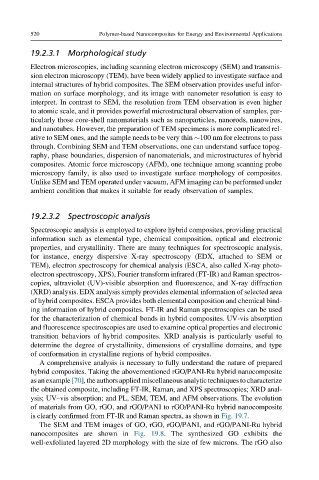Page 567 - Polymer-based Nanocomposites for Energy and Environmental Applications
P. 567
520 Polymer-based Nanocomposites for Energy and Environmental Applications
19.2.3.1 Morphological study
Electron microscopies, including scanning electron microscopy (SEM) and transmis-
sion electron microscopy (TEM), have been widely applied to investigate surface and
internal structures of hybrid composites. The SEM observation provides useful infor-
mation on surface morphology, and its image with nanometer resolution is easy to
interpret. In contrast to SEM, the resolution from TEM observation is even higher
to atomic scale, and it provides powerful microstructural observation of samples, par-
ticularly those core-shell nanomaterials such as nanoparticles, nanorods, nanowires,
and nanotubes. However, the preparation of TEM specimens is more complicated rel-
ative to SEM ones, and the sample needs to be very thin 100 nm for electrons to pass
through. Combining SEM and TEM observations, one can understand surface topog-
raphy, phase boundaries, dispersion of nanomaterials, and microstructures of hybrid
composites. Atomic force microscopy (AFM), one technique among scanning probe
microscopy family, is also used to investigate surface morphology of composites.
Unlike SEM and TEM operated under vacuum, AFM imaging can be performed under
ambient condition that makes it suitable for ready observation of samples.
19.2.3.2 Spectroscopic analysis
Spectroscopic analysis is employed to explore hybrid composites, providing practical
information such as elemental type, chemical composition, optical and electronic
properties, and crystallinity. There are many techniques for spectroscopic analysis,
for instance, energy dispersive X-ray spectroscopy (EDX, attached to SEM or
TEM), electron spectroscopy for chemical analysis (ESCA, also called X-ray photo-
electron spectroscopy, XPS), Fourier transform infrared (FT-IR) and Raman spectros-
copies, ultraviolet (UV)-visible absorption and fluorescence, and X-ray diffraction
(XRD) analysis. EDX analysis simply provides elemental information of selected area
of hybrid composites. ESCA provides both elemental composition and chemical bind-
ing information of hybrid composites. FT-IR and Raman spectroscopies can be used
for the characterization of chemical bonds in hybrid composites. UV-vis absorption
and fluorescence spectroscopies are used to examine optical properties and electronic
transition behaviors of hybrid composites. XRD analysis is particularly useful to
determine the degree of crystallinity, dimensions of crystalline domains, and type
of conformation in crystalline regions of hybrid composites.
A comprehensive analysis is necessary to fully understand the nature of prepared
hybrid composites. Taking the abovementioned rGO/PANI-Ru hybrid nanocomposite
asanexample[70],the authorsappliedmiscellaneousanalytic techniquesto characterize
the obtained composite, including FT-IR, Raman, and XPS spectroscopies; XRD anal-
ysis; UV–vis absorption; and PL, SEM, TEM, and AFM observations. The evolution
of materials from GO, rGO, and rGO/PANI to rGO/PANI-Ru hybrid nanocomposite
is clearly confirmed from FT-IR and Raman spectra, as shown in Fig. 19.7.
The SEM and TEM images of GO, rGO, rGO/PANI, and rGO/PANI-Ru hybrid
nanocomposites are shown in Fig. 19.8. The synthesized GO exhibits the
well-exfoliated layered 2D morphology with the size of few microns. The rGO also

